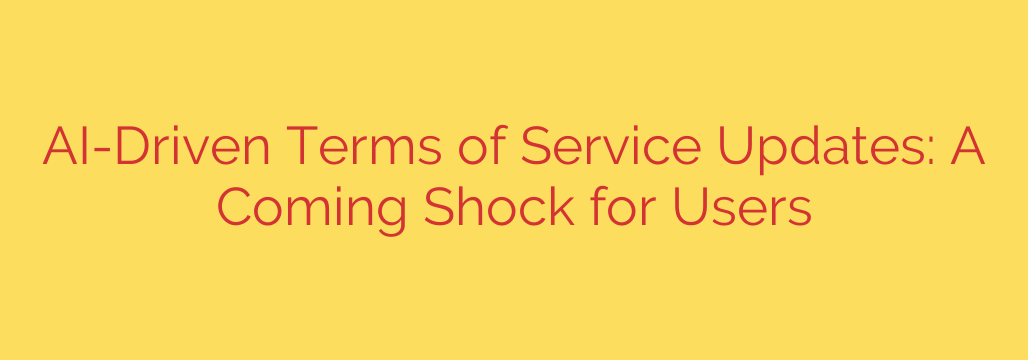
The Fine Print Gets Faster: How AI Is Changing Terms of Service Forever
We’ve all done it. A pop-up appears with pages of dense legal text—the dreaded Terms of Service update. With a sigh, we scroll to the bottom and click “I Agree” without reading a single word, just to get back to what we were doing.
This common habit is already risky, but it’s about to become significantly more dangerous. A new and powerful force is beginning to operate behind the scenes: artificial intelligence. Companies are starting to use AI to generate, manage, and update their legal agreements, and this shift will have profound consequences for your digital rights, your data, and your privacy.
The era of mindlessly clicking “agree” is over. Here’s what you need to know about the coming wave of AI-driven Terms of Service and how to protect yourself.
The New Reality: Constant, Automated Updates
Historically, Terms of Service (ToS) and privacy policies were updated infrequently. The process required expensive legal teams to draft, review, and approve changes. It was slow, deliberate, and costly for the company.
Artificial intelligence changes that equation entirely. AI can analyze massive datasets, legal precedents, and user behavior to draft and modify legal documents in seconds.
What does this mean for you?
- Terms of Service could soon change weekly or even daily. Instead of major annual updates, companies can deploy AI to make continuous, minor adjustments to optimize their legal standing, limit their liability, or expand their rights over your data.
- The changes will be harder to spot. An AI might only alter a few words in a 30-page document, but those words could fundamentally change your rights. For example, it could tweak the definition of “user content” to include more of your data.
The Hidden Risks in AI-Generated Fine Print
When an AI is programmed to optimize for a company’s best interests, it can lead to user agreements that are technically legal but deeply tilted against you. The speed and complexity of these changes create a perfect storm where users are left increasingly vulnerable.
Here are the primary risks to be aware of:
1. Your Content Becomes AI Training Fuel
Many services are racing to build the next generation of AI, and they need massive amounts of data to train their models. AI-generated ToS can subtly rewrite the rules on how your data is used. Your personal photos, documents, private messages, and creative work could become training data for a company’s next commercial AI model, often without any clear notification or option to opt-out.
2. Your Legal Rights Are Silently Eroded
Clauses that limit your ability to take legal action are already common, but AI can make them more pervasive and restrictive. Critical clauses that waive your right to a lawsuit and force you into binding arbitration could be subtly inserted or modified. Because few people read the full text, these changes often go unnoticed until it’s too late.
3. Ambiguity Becomes a Tool
While you might hope AI would create clearer legal documents, it can also be used to do the opposite. An AI can be trained to write clauses that are intentionally vague and open-ended. This ambiguity gives companies maximum flexibility to interpret the rules in their favor later on. A clause might state they can use your data for “service improvement,” a term so broad it could mean almost anything, including sharing it with third-party advertisers or data brokers.
4. The Pace Outstrips Human Oversight
The core problem is one of scale. It’s impossible for any individual to read and comprehend new 10,000-word legal agreements from every app and service they use, especially if they are changing every month. Regulators and consumer watchdog groups will also struggle to keep up, leaving users as the first—and often only—line of defense.
Actionable Security: How to Protect Yourself in the AI Era
Staying informed is your best defense. While you may not be able to read every word, you can adopt a smarter, more strategic approach to your digital agreements.
- Pay Attention to Update Notifications: Never dismiss a “Terms of Service has been updated” email or pop-up again. See it as a red flag that requires at least a moment of your attention.
- Leverage AI for Your Own Benefit: Fight fire with fire. Use services like ToS;DR (Terms of Service; Didn’t Read) or other emerging AI-powered tools that can summarize and analyze ToS documents for you. These tools can quickly highlight anti-user clauses.
- Focus on What Matters Most: If you only have a few minutes, use the “Find” function (Ctrl+F or Cmd+F) to search for critical keywords in the document. Focus on terms like “arbitration,” “waiver,” “data,” “privacy,” “third party,” “AI training,” and “user content.” Pay close attention to how these sections have changed.
- If You Don’t Agree, Be Prepared to Walk Away: If a company’s terms become too invasive—for instance, claiming ownership of your content or reserving the right to use your data for AI training—the most powerful action you can take is to stop using the service and delete your account.
The relationship between users and technology platforms is being rewritten, not by lawyers in boardrooms, but by algorithms. This new reality demands a new level of digital diligence from all of us. The next time you see that “I Agree” button, pause and remember: the fine print is no longer static. It’s alive, it’s learning, and it’s being optimized—and you need to know what you’re agreeing to.
Source: https://go.theregister.com/feed/www.theregister.com/2025/07/18/llm_products_terms_of_service/








